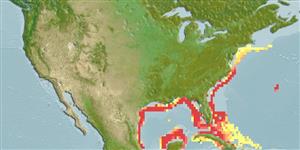Environment: milieu / climate zone / depth range / distribution range
Ökologie
seewasser demersal; tiefenbereich 45 - 230 m. Subtropical; 42°N - 19°N, 100°W - 66°W
Western Atlantic: New Jersey and northern Gulf of Mexico to southern Florida in USA and Cuba.
Size / Gewicht / Alter
Maturity: Lm ? range ? - ? cm
Max length : 40.0 cm TL Männchen/unbestimmt; (Ref. 7251)
Have a thick glandular tissue on posterior margin of fin spines which is believed to be venomous (Ref. 57406).
Life cycle and mating behavior
Geschlechtsreife | Fortpflanzung | Ablaichen | Eier | Fecundity | Larven
Fowler, H.W., 1935. Description of a new scorpaenoid fish (Neomerinthe hemingwayi) from off New Jersey. Proc. Acad. Nat. Sci. Phil. 87(1935):41-43. (Ref. 97626)
IUCN Rote Liste Status (Ref. 130435)
Nutzung durch Menschen
Mehr Information
Alter/GrößeWachstumLänge-GewichtLänge-LängeLängenhäufigkeitenMorphometrieMorphologieLarvenLarven Pop.Dyn.RekrutierungDichteBRUVS
ReferenzenAquakulturAquakultur ProfilZuchtlinienGenetikElectrophoresesVererbbarkeitKrankheitenVerarbeitungNutrientsMass conversion
PartnerBilderStamps, Coins Misc.LauteCiguateraGeschwindigkeitSchwimmstilKiemenoberflächeOtolithsGehirngrößeSehfähigkeit
Tools
Zusatzinformationen
Download XML
Internet Quellen
Estimates based on models
Preferred temperature (Ref.
123201): 18 - 26.4, mean 22.1 °C (based on 51 cells).
Phylogenetic diversity index (Ref.
82804): PD
50 = 0.5002 [Uniqueness, from 0.5 = low to 2.0 = high].
Bayesian length-weight: a=0.01259 (0.00606 - 0.02615), b=3.03 (2.86 - 3.20), in cm total length, based on LWR estimates for this (Sub)family-body shape (Ref.
93245).
Trophic level (Ref.
69278): 4.0 ±0.6 se; based on size and trophs of closest relatives
Widerstandsfähigkeit (Ref.
120179): niedrig, Verdopplung der Population dauert 4,5 - 14 Jahre. (Preliminary K or Fecundity.).
Fishing Vulnerability (Ref.
59153): Low to moderate vulnerability (30 of 100).
Nutrients (Ref.
124155): Calcium = 74.6 [38.0, 176.2] mg/100g; Iron = 1.03 [0.55, 2.10] mg/100g; Protein = 18.1 [16.4, 19.9] %; Omega3 = 0.56 [0.27, 1.47] g/100g; Selenium = 31.8 [16.0, 82.9] μg/100g; VitaminA = 17 [6, 49] μg/100g; Zinc = 0.775 [0.545, 1.133] mg/100g (wet weight);
